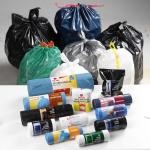
In August 2009 the ifeu Institute in Heidelberg published the results of a new life cycle assessment for dry (residual) waste refuse sacks and bin liners. The result: refuse sacks made of recycled polyethylene are superior to all other materials.
In the current life cycle assessment the environmental effects of dry waste refuse sacks made of primary PE (polyethylene) and completely or partially recycled PE were compared with each other. In addition, the environmental effects of refuse sacks in bio-degradable materials, such as those currently sold by the French and German retail trade, were examined with the aim of assessing the future environmentally-related potential of “organic refuse sacks”. The clients were European companies who manufacture refuse sacks using various materials and market them.
The thinner, the better
According to ifeu, the key data on the environmental effect profiles of the refuse sacks examined was provided by the raw material production stage. They found that the data from raw material processing in refuse sack production and from transport to the retail outlets was much less relevant. Only waste incineration following dry waste collection provided key data for the “climatic change” effect category due to the CO2 emissions released in the process. Correspondingly, the environmental performance of all types of refuse sacks is better the thinner, and as a result, the lighter they are. The functional-technical requirements do however place restrictions on weight reduction. These in turn are dependent on the material processed.
For the purposes of the study a series of environmental effect categories were used in order to assess the environmental characteristics of the refuse sacks examined. Indicators were selected, which are widely used in European life cycle assessments. On the one hand this is the resource-related category of “fossil fuels/energy resources”, which relates to the degradation of fossil fuels. In addition, also the emission-related categories such as “climatic change”, “photo-oxidants formation” and acidification. Terrestrial and/or aquatic eutrophication, i.e. all pollution caused by excessive nutrient intake in eco systems such as soils and water elements, was also taken into account.
Environmentally-friendly PCR refuse sacks
The conclusion reached by the Institute for Energy & Environmental Research (Institut für Energie- und Umweltforschung - ifeu) was that refuse sacks made of genuine PCR (Post Consumer Recyclate) have the best environmental impact profile overall and therefore confirm that this is the most environmentally friendly raw material for refuse sacks. The precondition is however that the PCR sacks and liners are produced in film thicknesses similar to those of PE bags and that they fulfil the functional and technical requirements. They were followed in second place by the dry (residual) waste refuse sacks in new polyethelyne. As a result, the polyethylene materials, even in the emission-related categories – for example the CO2 emissions category – were superior.
The Institute also found that the organically based refuse sacks currently available on the market, in other words the so-called bio-degradable waste sacks, had produced less positive environmental effect profiles than the PE and PCR bags in the life cycle assessment. The disadvantages of the organic waste sacks were mainly due to the fairly high film thickness and associated material volume in connection with the relatively high fossil raw materials content. (In this connection it was explicitly pointed out that BASF is not recommending its own-produced organic synthetics used in refuse sacks for dry waste collection, but exclusively for organic waste.)
Improvements expected
However, in future we can expect further improvements particularly in the area of organic refuse sacks. The aim is to achieve this particularly through the setting-up of larger production facilities and further weight reductions thanks to optimized product characteristics. On the other hand the ifeu Institute pointed out that none of the optimization scenarios conducted here indicated that such measures would result in an improved environmental performance of the PE bags currently used.
As far as the German Association for Plastics Packagings & Films (IK Industrievereinigung Kunststoffverpackungen e.V.) is concerned, these scientific findings showed that discrimination against conventional plastics or synthetics within the framework of legislative measures – such as those now planned in France – was not justified.
The ifeu Institute for Energy and Environmental Research was founded over 30 years ago and has a staff of around 50. Their specialist expertise and competence covers areas such as transport, energy supply and renewable energies, life cycle assessments, air pollution control, sustainable development, environmental effect/impact assessment and environmental management.
Source: interpack
Tel:886-2-28941823 Fax:886-2-28941837 E-mail:viya@packsourcing.com
Copyright Notice © 2015 New Insight Publishing Ltd.. All rights reserved.
Powered by Packsourcing